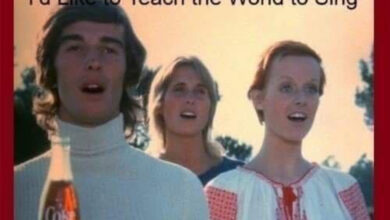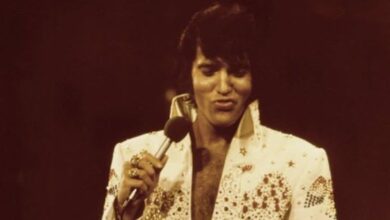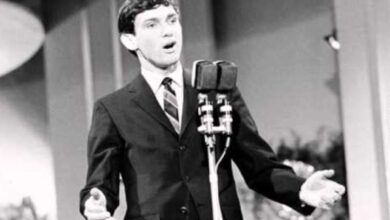The Platters’ “Twilight Time” and Its Enduring Elegance in 1958
In 1958, The Platters released “Twilight Time,” a shimmering ballad that captured the romance and sophistication of its era. With its lush harmonies and smooth orchestration, the song quickly climbed the charts, reaching number one on the Billboard Hot 100. Its success was no surprise; the track’s timeless quality and emotional resonance made it an instant favorite. “Twilight Time” not only cemented The Platters’ status as one of the preeminent vocal groups of the 1950s but also demonstrated how rhythm and blues could seamlessly merge with pop music to create something transcendent.
The Platters, originally formed in Los Angeles in 1952, stood apart from their contemporaries with their elegant stage presence and polished sound. Comprising lead tenor Tony Williams, David Lynch, Paul Robi, Herb Reed, and later Zola Taylor, the group’s sophisticated vocal style was often likened to a choir. Williams’ powerful and emotive delivery gave their ballads a distinct emotional depth. Under the management of Buck Ram, who also served as their producer and songwriter, The Platters rose to prominence as one of the first African American groups to achieve mainstream success, appealing to both black and white audiences during a time of racial segregation.
“Twilight Time” was not a new composition when The Platters recorded it. The song was originally an instrumental piece composed by the trio of Artie Dunn, Al Nevins, and Morty Nevins, collectively known as The Three Suns. Its lyrical adaptation came later, with songwriter Buck Ram adding romantic verses that complemented the melody’s dreamy quality. The lyrics spoke of longing and tender devotion, capturing the intimate beauty of dusk — a theme that resonated deeply with listeners.
Recording “Twilight Time” at the height of their career, The Platters brought their signature blend of elegance and passion to the track. The session took place at Capitol Records’ iconic studios, with orchestral arrangements that elevated the song’s cinematic quality. Tony Williams’ soaring lead vocals were balanced by the group’s lush harmonies, while the sweeping strings and gentle percussion added an atmospheric warmth. The production was meticulously crafted to emphasize the song’s emotional core, making it a quintessential example of the era’s sophisticated pop sound.
Upon its release, “Twilight Time” received widespread acclaim. It topped not only the pop charts but also the R&B charts, underscoring The Platters’ crossover appeal. Fans and critics alike praised the group’s ability to convey deep emotion with graceful restraint. The song’s success further solidified their reputation as pioneers of pop balladry. In a musical landscape still dominated by rock and roll’s youthful exuberance, “Twilight Time” offered a more mature, romantic alternative that resonated across generations.
Beyond its commercial achievements, “Twilight Time” played a significant cultural role. The Platters’ mainstream success represented a milestone for African American artists seeking recognition in a segregated industry. By consistently topping the charts and performing to integrated audiences, they broke barriers and expanded the possibilities for future artists. The song’s universal themes of love and devotion transcended racial and social divisions, making it a beloved standard in American popular music.
For The Platters, “Twilight Time” was a career-defining hit that opened doors to international fame. They toured extensively, performing in venues across the United States and Europe, where they were embraced by adoring fans. While they continued to release successful singles like “Smoke Gets in Your Eyes” and “Harbor Lights,” “Twilight Time” remained one of their most requested and cherished performances. Its enduring popularity ensured that it would remain a fixture in their live shows for years to come.
The song’s influence extended well beyond its initial release. It became a staple on radio stations and a favorite choice for romantic occasions. Its lush orchestration and heartfelt lyrics inspired countless artists, and the track was covered by performers spanning multiple genres. Notable renditions by artists like Andy Williams and Johnny Mathis paid homage to the song’s emotional resonance while introducing it to new audiences.
Personal triumphs and challenges also marked the period surrounding “Twilight Time.” While The Platters enjoyed immense success, they faced pressures from a rapidly evolving music industry. Despite these challenges, the group’s commitment to artistic excellence never wavered. Tony Williams’ departure from the group in the early 1960s brought a shift in their sound, but the legacy of songs like “Twilight Time” ensured their continued relevance.
Today, the song’s legacy endures. “Twilight Time” remains a symbol of mid-century romanticism, often evoking memories of elegant dances and moonlit evenings. It continues to receive regular airplay on classic hits stations and features in countless film and television soundtracks, preserving its place in the cultural fabric. Its inclusion in various retrospective collections and tributes further solidifies its status as one of the defining love songs of the 20th century.
In retrospect, the success of “Twilight Time” was not simply a testament to The Platters’ vocal talent but also to their ability to capture the emotions of their listeners. The song’s enduring appeal lies in its simplicity and sincerity — a heartfelt expression of devotion that resonates as strongly today as it did in 1958. For those who have ever stood beneath the fading light of dusk, “Twilight Time” serves as a reminder of love’s quiet beauty and the timeless power of a perfect melody.


